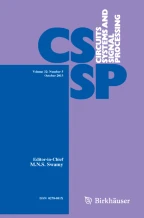Abstract
Since context-based adaptive binary arithmetic coding (CABAC) as the entropy coding method in H.264/AVC was originally designed for lossy video compression, it is inappropriate for lossless video compression. Based on the fact that there are statistical differences of residual data between lossy and lossless video compression, we propose an efficient differential pixel value coding method in CABAC for H.264/AVC lossless video compression. Considering the observed statistical properties of the differential pixel value in lossless coding, we modified the CABAC encoding mechanism with the newly designed binarization table and the context-modeling method. Experimental results show that the proposed method achieves an approximately 12% bit saving, compared to the original CABAC method in the H.264/AVC standard.
Similar content being viewed by others
References
Editors’ draft revision to ITU-T Rec. H.264|ISO/IEC 14496-10 Advanced Video Coding—in preparation for ITU-T SG17 AAP Consent, Document JVT-AD205.doc, Joint Video Team of ISO/IEC 14496-10 AVC, ISO/IEC JTC1/SC29/WG11 and ITU-T Q.6/SG16, 2009
R.G. Gallager, D.C. Van Voorhis, Optimal source codes for geometrically distributed integer alphabets. IEEE Trans. Inf. Theory 21(2), 228–230 (1975)
J. Heo, Y.-S. Ho, Efficient level and zero coding methods for H.264/AVC lossless intra coding. IEEE Signal Process. Lett. 17(1), 87–90 (2010)
J. Heo, S.-H. Kim, Y.-S. Ho, Improved CAVLC for H.264/AVC lossless intra coding. IEEE Trans. Circuits Syst. Video Technol. 20(2), 213–222 (2010)
Joint Video Team, Reference Software Version 13.2 [Online]. Available: http://iphome/hhi.de/shehring/tml/download/old_jm/jm13.2.zip
Y.-L. Lee, K.-H. Han, G.J. Sullivan, Improved lossless intra coding for H.264/MPEG-4 AVC. IEEE Trans. Image Process. 15(9), 2610–2615 (2006)
H. Malvar, A. Hallapuro, M. Karczewicz, L. Kerofsky, Low-complexity transform and quantization in H.264/AVC. IEEE Trans. Circuits Syst. Video Technol. 13(7), 598–603 (2003)
D. Marpe, H. Schwarz, T. Wiegand, Context-based adaptive binary arithmetic coding in the H.264/AVC video compression. IEEE Trans. Circuits Syst. Video Technol. 13(7), 620–636 (2003)
J.-H. Nam, D. Sim, Lossless video coding based on pixel-wise prediction. Multimed. Syst. 14(5), 291–298 (2008)
I.E.G. Richardson, H.264/MPEG-4, part 10, in H.264 and MPEG-4 Video Compression (Wiley, New York, 2003), pp. 201–207
K. Sayood, Lossless image compression, in Introduction to Data Compression (Morgan Kaufmann, San Mateo, 2006), pp. 170–172
G.J. Sullivan, T. Wiegand, Video compression—from concepts to the H.264/AVC standard. Proc. IEEE 93(1), 18–31 (2005)
G.J. Sullivan, P. Topiwala, A. Luthra, The H.264/AVC advanced video coding standard: Overview and introduction to the fidelity range extensions, in Proc. SPIE Conf., Special Session Adv. New Emerg. Standard: H.264/AVC (2004), pp. 454–474
J. Teuhola, A compression method for clustered bit-vectors. Inf. Process. Lett. 7, 308–311 (1978)
M.J. Weinberger, G. Seroussi, G. Sapiro, The LOCO-I lossless image compression algorithm: Principles and standardization into JPEG-LS. IEEE Trans. Image Process. 9(8), 1309–1324 (2000)
T. Wiegand, G.J. Sullivan, G. Bjøntegaard, A. Luthra, Overview of the H.264/AVC video coding standard. IEEE Trans. Circuits Syst. Video Technol. 13(7), 560–576 (2003)
Author information
Authors and Affiliations
Corresponding author
Rights and permissions
About this article
Cite this article
Heo, J., Ho, YS. Efficient Differential Pixel Value Coding in CABAC for H.264/AVC Lossless Video Compression. Circuits Syst Signal Process 31, 813–825 (2012). https://doi.org/10.1007/s00034-011-9338-1
Received:
Revised:
Published:
Issue Date:
DOI: https://doi.org/10.1007/s00034-011-9338-1
